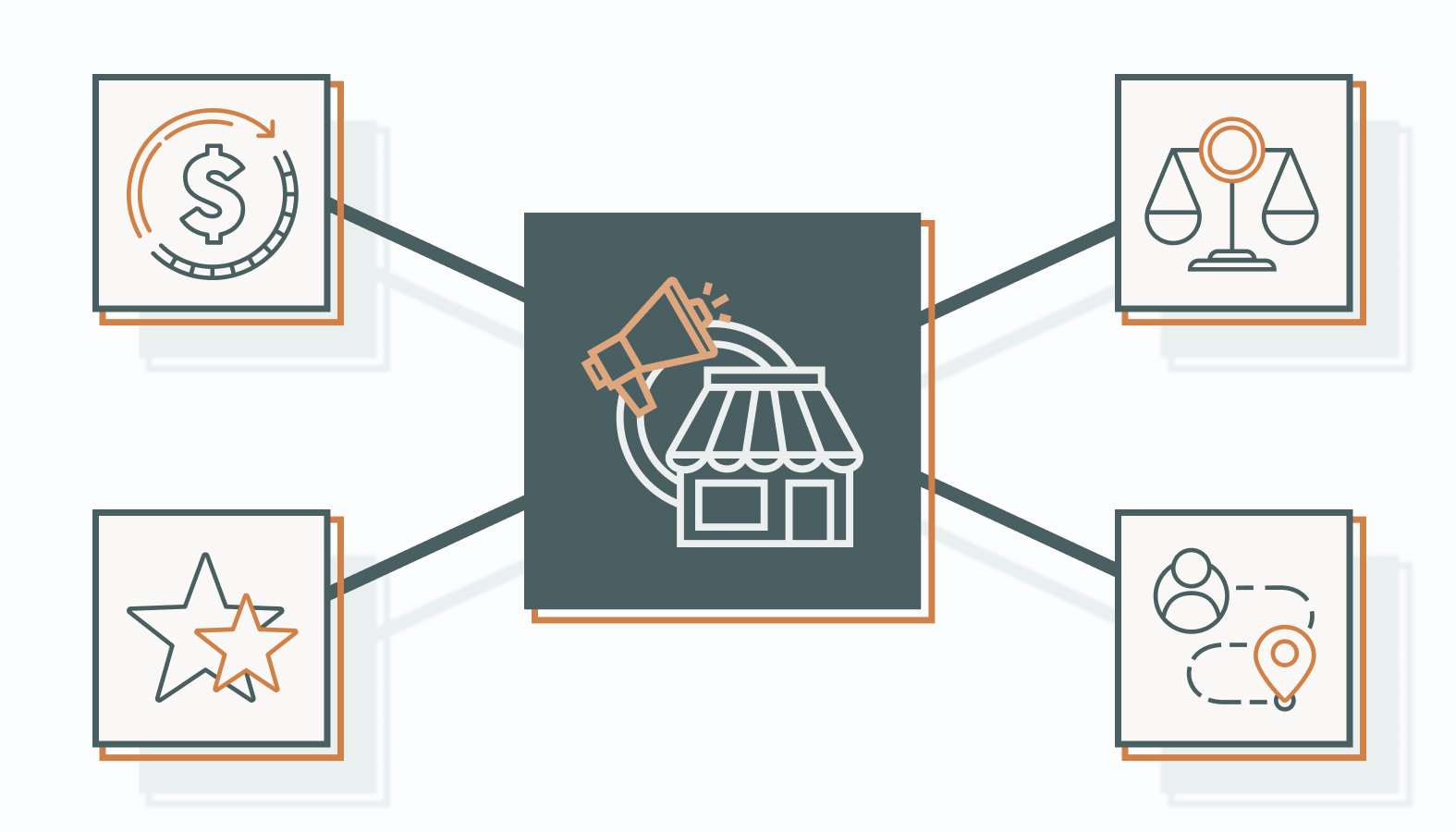Everyone talks about sustainability, but few businesses know how to communicate it in a way that’s clear, honest, and impactful. That’s the challenge of marketing sustainability: it’s not enough to highlight small eco-friendly steps; customers expect to see a bigger commitment backed by real action. And if that message isn’t delivered with transparency, it risks sounding like empty hype.
The flip side? Brands that embrace sustainable marketing the right way build stronger trust, attract loyal customers, and often uncover new opportunities for growth. They prove that doing good for the environment and doing well in business can go together.
In this guide, we’ll break down what sustainable marketing really is, how to avoid common mistakes, and how leading companies are setting the standard. Stick around to see that building a sustainable brand isn’t just possible, it’s practical.
Sustainable Marketing 101
Sustainable marketing is more than a buzzword. It’s how forward-thinking businesses communicate care for people, the planet, and profits in a way that actually resonates.
Consumers today notice when brands make real commitments versus superficial gestures, so clarity and credibility are everything.
What is Sustainable Marketing?
Sustainable marketing is about promoting products and services responsibly while balancing three key factors:
- Environmental impact: Minimizing harm to the planet through smarter production, sourcing, and operations.
- Social responsibility: Considering the well-being of communities, employees, and society at large.
- Economic viability: Ensuring business strategies are profitable and sustainable over the long term.
The ultimate goal is simple: deliver value today without compromising tomorrow’s opportunities.
Think of it as a roadmap for brands that aim to succeed while driving positive impact. For example, Whole Foods prioritizes local, organic sourcing, linking environmental responsibility with community well-being.
Sustainable Marketing vs. Greenwashing
Greenwashing happens when companies exaggerate or misrepresent eco-credentials. Vague claims, selective reporting, or overhyping minor eco-efforts can erode trust and trigger backlash. Consumers are quick to notice, and the consequences can be serious.
Greenwashing Examples
Greenwashing can confuse consumers and, if uncovered, seriously damage a brand’s reputation.
Common tactics include:
- Using vague eco-friendly claims without proof. For example, a cleaning product labeled “eco-friendly” without disclosing ingredients or certifications.
- Highlighting irrelevant environmental actions. A good example of this is a clothing brand promoting recyclable hangers while ignoring high water usage in production.
- Presenting minor efforts as major achievements. For instance, a fast-food chain advertising compostable straws as a big step, while the majority of packaging remains non-recyclable.
- Selective disclosure of information. Example: A company sharing that 20% of their energy comes from renewable sources, while omitting that 80% still comes from fossil fuels.
These tactics may temporarily appeal to eco-conscious consumers, but they erode trust and can spark backlash once customers see the disconnect between messaging and actual practices.
Benefits of Genuine Sustainable Marketing
Authentic sustainable marketing sets the stage for meaningful results, without relying on gimmicks or empty promises.
When brands commit with clarity and measurable action, they unlock advantages that go beyond optics:
- Strengthens Strategic Positioning: Sustainability integrated at the core signals leadership, foresight, and a brand that’s ready for tomorrow.
- Drives Operational Efficiency: Streamlined processes, reduced waste, and smart resource use translate into smoother operations and lower costs.
- Enhances Employee Engagement: Teams rally behind initiatives that reflect purpose and values, boosting motivation, retention, and internal culture.
- Fosters Innovation: Tackling sustainability challenges inspires new ideas, products, and services that differentiate a brand in competitive markets.
- Builds Stakeholder Confidence: Investors, partners, and collaborators respond positively to brands that align responsibility with measurable outcomes.
In short, genuine sustainable marketing offers feel-good messaging and elevates operations, people, and future growth potential.
Importance of Sustainable Marketing
Sustainable marketing is no passing trend. It’s a strategic advantage for businesses that want to thrive while staying ahead of evolving consumer expectations. Eco-conscious audiences are savvy —they reward brands that act with transparency, measurable impact, and purpose-driven messaging.
Here’s how sustainable marketing creates real value:
Financial Benefits
Sustainable marketing drives measurable impact on the bottom line. Streamlining operations, reducing waste, and optimizing resource use translate into real cost savings, making environmentally conscious choices financially smart as well as ethically sound.
Companies that integrate energy-efficient processes or recycled materials often see notable reductions in production and operational costs.
Take Seventh Generation, for example. By designing household products with sustainable materials and minimizing packaging waste, they’ve not only cut costs but also strengthened their market position, proving that environmental responsibility and profitability can advance hand in hand.
Ethical and Social Responsibility
Marketing that reflects ethical standards resonates deeply with today’s conscious consumers. When a brand demonstrates a tangible commitment to social and environmental causes, it signals integrity and purpose.
Ben & Jerry’s has long leveraged this principle, advocating for social justice and environmental responsibility in ways that reinforce both their moral standing and their connection with a loyal customer base. Sustainability here is more than messaging; it’s a visible demonstration of values that customers can trust.
Enhancing Corporate Reputation
A clear and transparent approach to sustainability elevates a company’s public perception. Communicating authentic environmental initiatives helps a brand stand out as reliable, forward-thinking, and credible.
Coca-Cola’s “World Without Waste” program, aiming to collect and recycle a bottle or can for every one sold, exemplifies how large-scale commitments can enhance reputation.
Consumers, investors, and partners respond positively to brands that don’t just talk about responsibility but integrate it visibly into their operations.
Customer Loyalty and Retention
Genuine sustainability fosters enduring relationships with consumers. Brands that prioritize environmental and social responsibility build trust, loyalty, and advocacy among audiences who care about these issues.
Lush Cosmetics, renowned for ethical sourcing and minimal packaging, demonstrates how transparency and commitment can cultivate a dedicated following.
Customers recognize authenticity and reward it with repeat engagement, proving that sustainable marketing can be a strategic driver of long-term loyalty and competitive advantage.
How to Implement Sustainable Marketing
Implementing sustainable marketing requires more than a checklist. It demands a strategic, end-to-end approach that embeds environmental and social considerations into every touchpoint of a brand’s operations and communications.
Here’s how to make it happen:
1) Conduct a Sustainability Audit
The first step is getting a clear, data-driven snapshot of where your company stands. A sustainability audit goes beyond surface-level claims to identify environmental and social impacts across your business.
Analyzing Current Practices
Examine the full product lifecycle, from raw materials to disposal. Tools like life cycle assessments (LCA) and carbon footprint calculators provide hard metrics, while stakeholder surveys and interviews reveal perceptions and hidden pain points.
Identifying Key Areas for Change
Pinpoint where improvements will make the most difference. High-impact areas often include energy usage, supply chain practices, waste management, and packaging.
Establish clear goals using SMART criteria (specific, measurable, achievable, relevant, and time-bound) to hold the organization accountable.
A thorough audit sets the foundation for strategic choices rather than reactive adjustments. It tells you exactly where your efforts will have the greatest impact on both consumers and operational efficiency.
2) Craft a Sustainable Marketing Plan
Once you know where you stand, the next step is translating insights into an actionable plan. Alignment across business functions ensures sustainability initiatives become part of the company’s operational DNA.
Setting Objectives
Define tangible targets, such as reducing single-use packaging by a measurable percentage over a defined timeframe or sourcing a higher proportion of certified sustainable materials. Objectives clarify priorities, guide investments, and make success measurable.
Integrating Across the Organization
Sustainability should influence every department, not just marketing. Operations, finance, product development, and HR all play a role. Establish cross-functional teams, regular meetings, and training programs to foster shared ownership.
Leveraging Digital Tools
Modern platforms provide a strategic edge. Shopify, for instance, allows brands to track product-related carbon emissions, giving a quantifiable measure of environmental impact.
Social channels like Instagram and LinkedIn offer spaces to communicate verified sustainability metrics directly to audiences.
E-commerce tools such as EcoCart and Offset let businesses embed carbon offsetting into the checkout process, turning sustainable choices into measurable outcomes. These aren’t optional extras — they reinforce credibility while generating tangible environmental impact.
3) Connect with Stakeholders
Sustainability gains traction when it engages the right people, inside and outside the company.
Internal Engagement
Employees become champions when they see purpose-driven initiatives in action. Green teams, sustainability ambassadors, and reward programs create a culture of accountability and pride. This internal alignment ensures sustainability isn’t a marketing slogan—it’s a lived value.
External Partnerships
Collaborations expand reach and enhance credibility. NGOs, suppliers, industry groups, and even strategic brand partners can provide expertise, amplify messaging, and open new opportunities.
Starbucks’ collaboration with Conservation International is a prime example: sustainable coffee sourcing benefits both the environment and supply chain integrity, strengthening the brand’s reputation while driving measurable outcomes.
The Bottom Line
Sustainable marketing is strategic, measurable, and influential. It starts with understanding where your business stands, continues with planning and execution that embeds responsibility into every function, and thrives when stakeholders — both inside and outside the company — are actively engaged.
Examples of Marketing Sustainability in Brands
Looking at brands that have nailed sustainable marketing gives more than inspiration; it shows what’s possible when strategy, ethics, and communication align. These companies aren’t just talking; they’re executing with measurable impact.
Patagonia: Activism Drives Brand Loyalty
Patagonia has built its brand around environmental activism, making sustainability inseparable from its identity.
- What Worked: Patagonia’s “1% for the Planet” pledge to “donate 1% of sales to environmental causes” signals a concrete commitment rather than empty marketing.
Campaigns like “Don’t Buy This Jacket” challenged conventional retail thinking, encouraging consumers to reflect on consumption and environmental impact.
- How They Walked the Talk: Patagonia reinforces messaging through action: recycled materials, transparent supply chains, and investments in regenerative agriculture. These operational choices amplify marketing, building both trust and loyalty.
IKEA: Innovation Meets Circular Economy
IKEA approaches sustainability as an operational and marketing opportunity.
- What Worked: IKEA’s “People & Planet Positive” initiative aims to source only renewable or recycled materials by 2030.
Marketing campaigns spotlight furniture take-back programs, energy-efficient products, and everyday tips for sustainable living.
- How They Walked the Talk: By embedding circular economy principles into operations—like recycling, take-back schemes, and product life extension—IKEA turns sustainability into a brand differentiator that consumers can see, feel, and participate in.
Tesla: Redefining Clean Energy Lifestyle
Tesla’s sustainable marketing isn’t just about products; it’s a story of reshaping an entire industry.
- What Worked: Tesla markets more than cars; it markets a lifestyle. Messaging highlights zero emissions, renewable energy, and lower long-term operating costs, framing sustainability as aspirational. Their storytelling positions the brand at the forefront of the clean-energy revolution.
- How They Walked the Talk: Tesla backs its narrative with operational choices: electric vehicles, solar solutions, and battery technology partnerships. This synergy between story and action strengthens credibility and fuels market leadership.
Unilever: Sustainable Living at Scale
Unilever has made sustainable living a central pillar of its business and marketing.
- What Worked: The “Unilever Sustainable Living Plan” drives measurable environmental and social outcomes across brands.
Dove campaigns advocate for real beauty and responsible sourcing, while Ben & Jerry’s focuses on climate justice and ethical sourcing.
- How They Walked the Talk: Each brand under Unilever’s umbrella integrates sustainability into its core operations, from sourcing to production. This consistency turns ethical commitment into a cohesive marketing advantage that resonates with conscious consumers.
Oceanfoam: Packaging Innovation for Impact
Oceanfoam is carving out a niche by tackling one of the most visible environmental challenges: packaging waste.
- What Worked: Oceanfoam tackles packaging waste head-on with compostable foams and eco-friendly alternatives.
Marketing clearly communicates environmental benefits, appealing to brands looking for sustainable solutions.
- How They Walked the Talk: Operationally, Oceanfoam creates measurable impact through innovative product design and supply chain choices. Marketing leverages these innovations, turning B2B solutions into a compelling narrative that drives growth.
Common Mistakes in Sustainable Marketing
Sustainable marketing has high stakes. When executed well, it can elevate a brand, strengthen loyalty, and open new market opportunities. Missteps, however, can undo all that effort and damage credibility.
Here’s how top brands avoid common pitfalls and keep sustainability authentic, measurable, and impactful.
Overpromising Without Proof
Claiming more than you deliver is a fast track to distrust. Transparency isn’t negotiable.
Take Method, the cleaning products brand: their marketing is backed by third-party certifications and clear disclosures about ingredient sourcing and environmental impact. By sharing measurable results rather than broad claims, Method builds trust instead of hype.
Communicating in a Vacuum
A brilliant sustainability strategy can fail if audiences don’t understand it. Messaging must be precise, consistent, and tailored for different stakeholders like customers, employees, and investors.
Apple’s environmental responsibility reports demonstrate how clear, visually engaging communication of goals and progress reinforces credibility and inspires action.
Ignoring the Supply Chain
Sustainability is only as strong as the weakest link. A comprehensive view includes suppliers, production, and logistics. Conduct audits, set clear expectations, and collaborate with partners to lift standards across the board.
Nestlé’s sustainable sourcing programs illustrate how supply chain accountability can translate into both ethical and operational wins, ensuring sustainability isn’t confined to marketing materials but embedded into the business ecosystem.
Leaving Stakeholders Out of the Loop
Impact requires inclusion. Employees, suppliers, customers, and investors all need a role in the journey.
Engagement can take many forms: collaborative initiatives, feedback loops, or recognition programs that highlight individual and team contributions.
Marks & Spencer’s “Plan A” exemplifies this by engaging both staff and consumers in sustainability initiatives, driving broader adoption and real measurable outcomes.
Inconsistent Messaging and Action
Sporadic campaigns or one-off initiatives signal a lack of commitment.
Brands like The Body Shop maintain alignment between operations and marketing (from ethical sourcing to cruelty-free products), which reinforces credibility and shows that sustainability is part of their DNA.
Short-Term Thinking
Treating sustainability as a fleeting trend is a recipe for failure. Long-term integration into operations, culture, and strategy ensures enduring impact, stronger brand equity, and loyal communities that trust your vision.
The bottom line: The most damaging mistakes in sustainable marketing are avoidable, but only if transparency, clarity, accountability, stakeholder engagement, and consistency are embedded across the organization.
Skipping any of these steps risks turning your green initiatives into greenwashing, with real consequences for trust and growth.
Building a Sustainable Brand: The Path to Long-Term Value
Building a sustainable brand is a strategic advantage. By integrating environmental and social responsibility into your core operations and communications, your brand can earn trust, loyalty, and measurable impact.
Here are the core principles to guide your brand’s sustainability journey:
- Sustainability as Strategy: Embed across operations, marketing, and culture.
- Transparency Wins: Back every claim with measurable results.
- Stakeholder Momentum: Engage employees, partners, and customers.
- Think Ahead: Make sustainability an ongoing commitment.
- Communicate with Clarity: Simple, compelling messaging wins trust.
- Measure, Refine, Repeat: Track progress and showcase results.
By following these principles, your brand not only avoids the pitfalls of greenwashing but positions itself for lasting relevance, loyalty, and growth.
Turn Sustainability Into Your Strategic Advantage
Marketing sustainability done right enhances brand credibility, inspires stakeholders, and positions your company at the forefront of conscious, forward-thinking business.
Ready to move beyond surface-level green messaging? Our team can help you embed sustainability into every layer of your business, turning strategy into measurable impact, and impact into lasting value.
Schedule a candid conversation with one of our experts to explore actionable, high-impact sustainability strategies. No empty promises; just a straight path to building a future-ready brand that resonates with today’s conscious consumer.










